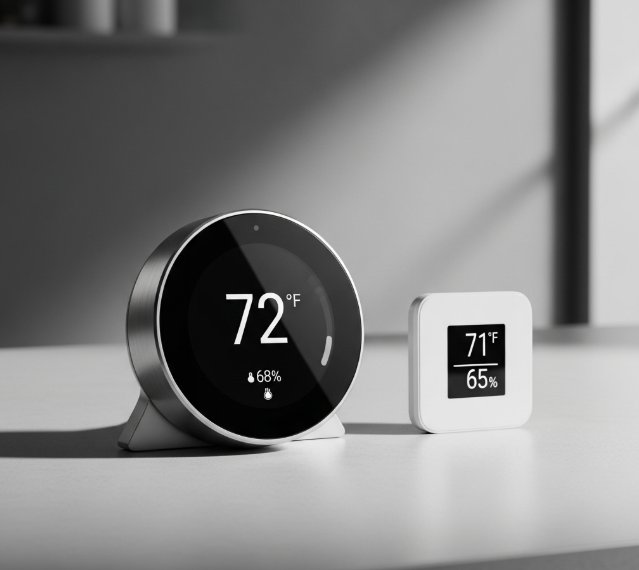
Home Security
Protect what matters most
with state-of-the-art technology and peace of mind at your fingertips. Whether you're at home or away, our smart system delivers round-the-clock monitoring, instant alerts, and seamless integration with your devices. From HD cameras to motion detection and smart locks, we ensure your home stays safe and secure, giving you the confidence to live without worry. Trust P&J Tech to safeguard your home, family, and everything you hold dear.
Motion Detectors
-
These sensors detect movement within a defined area, typically using infrared or microwave technology.
-
Usually mounted in corners or on walls, commonly in hallways, living rooms, or entryways.
Motion detectors use passive infrared (PIR) sensors to detect heat signatures from people or animals moving across the sensor's field of view. Some advanced models use both infrared and ultrasonic signals to improve accuracy.
-
Can trigger alarms or notify you when unusual motion is detected.
Some models can differentiate between humans and pets, reducing false alarms.
Available in indoor and outdoor versions.
Door and Windows Sensors
-
These sensors are placed on doors or windows to detect when they are opened or tampered with.
-
Installed on doors and windows throughout your home—especially on entry points.
Composed of two parts: one part is placed on the door or window frame, and the other is placed on the door or window itself. When the door or window opens, the magnetic field between the two parts is broken, triggering an alert.
-
Can be connected to your alarm system for immediate alerts.
Often integrated with smart home systems to lock/unlock doors remotely.
Available with features like tamper detection (alerts if the sensor is removed).
Glass Break Sensors
-
Detects the sound of glass breaking (like a window being smashed).
-
Installed near windows or glass doors, often in living rooms, kitchens, or areas with large glass surfaces.
These sensors are equipped with microphones that listen for the unique frequency or sound pattern made by breaking glass. Some models can also detect vibration or pressure changes caused by impact.
-
Can differentiate between the sound of breaking glass and other noises, reducing false alarms.
Ideal for homes with many windows or glass doors.
Smoke Detectors
-
Detects the presence of smoke, often indicating a fire.
-
Typically placed in hallways, kitchens (away from cooking areas), and bedrooms.
Most smoke detectors use either ionization or photoelectric technology. Ionization sensors detect smoke particles by measuring the disruption of electrical currents, while photoelectric sensors detect changes in light patterns caused by smoke particles.
-
Some models are combined with carbon monoxide detectors.
Integrated into home security systems to notify you when smoke is detected, even if you’re not home.
Carbon Monoxide Detectors
-
Detects the presence of carbon monoxide, a colorless, odorless gas that can be deadly in high concentrations.
-
Near sleeping areas, in basements, or near gas-powered appliances.
These detectors measure the concentration of carbon monoxide in the air. When levels reach a dangerous threshold, an alarm is triggered.
-
Alerts you to toxic gas buildup before it becomes a health threat.
Often integrated with smoke detectors in one device.
Floor Sensors
-
Detects water or flood conditions, alerting homeowners to leaks, pipe bursts, or flooding.
-
Near water heaters, washing machines, sinks, and in basements prone to flooding.
These sensors are typically placed on the floor in areas like basements, kitchens, or bathrooms. They use conductivity or capacitance to detect the presence of water.
-
Sends notifications when water is detected.
Can be programmed to shut off the water supply automatically in some advanced systems.
Temperature Detectors
-
Monitors the temperature in your home or specific rooms.
-
Commonly used in attics, basements, or areas prone to extreme temperatures.
These sensors track temperature changes and alert homeowners if it goes outside a set range, which could indicate a fire, freeze danger, or unusual environmental conditions.
-
Can be combined with smart thermostats for temperature control.
Often used in areas vulnerable to freezing (e.g., crawlspaces, garages).
Motion-Activated Cameras
-
These cameras capture video or images when motion is detected in their field of view.
-
Commonly placed at entry points, along walkways, or in outdoor areas.
Integrated with motion detectors, these cameras begin recording as soon as movement is detected. They can stream live footage to your smartphone or storage device.
-
Night vision for 24/7 surveillance.
Can be triggered by pets or people and offer real-time alerts.
Often come with two-way audio, allowing homeowners to speak through the camera
Panic Buttons
-
A personal safety device that can instantly alert your security system or emergency responders in the event of an emergency.
-
Commonly placed near beds, in bedrooms, or in areas where you may need help quickly.
Can be pressed manually, either as a wall-mounted button or a portable device (like a wristband or pendant). When pressed, the alarm triggers an emergency alert to monitoring centers.
-
Direct connection to emergency services.
Often integrated with home security systems for faster response times.

Receive real-time alerts, adjust settings, and even see live video feeds from cameras all from the convenience of your smartphone.









